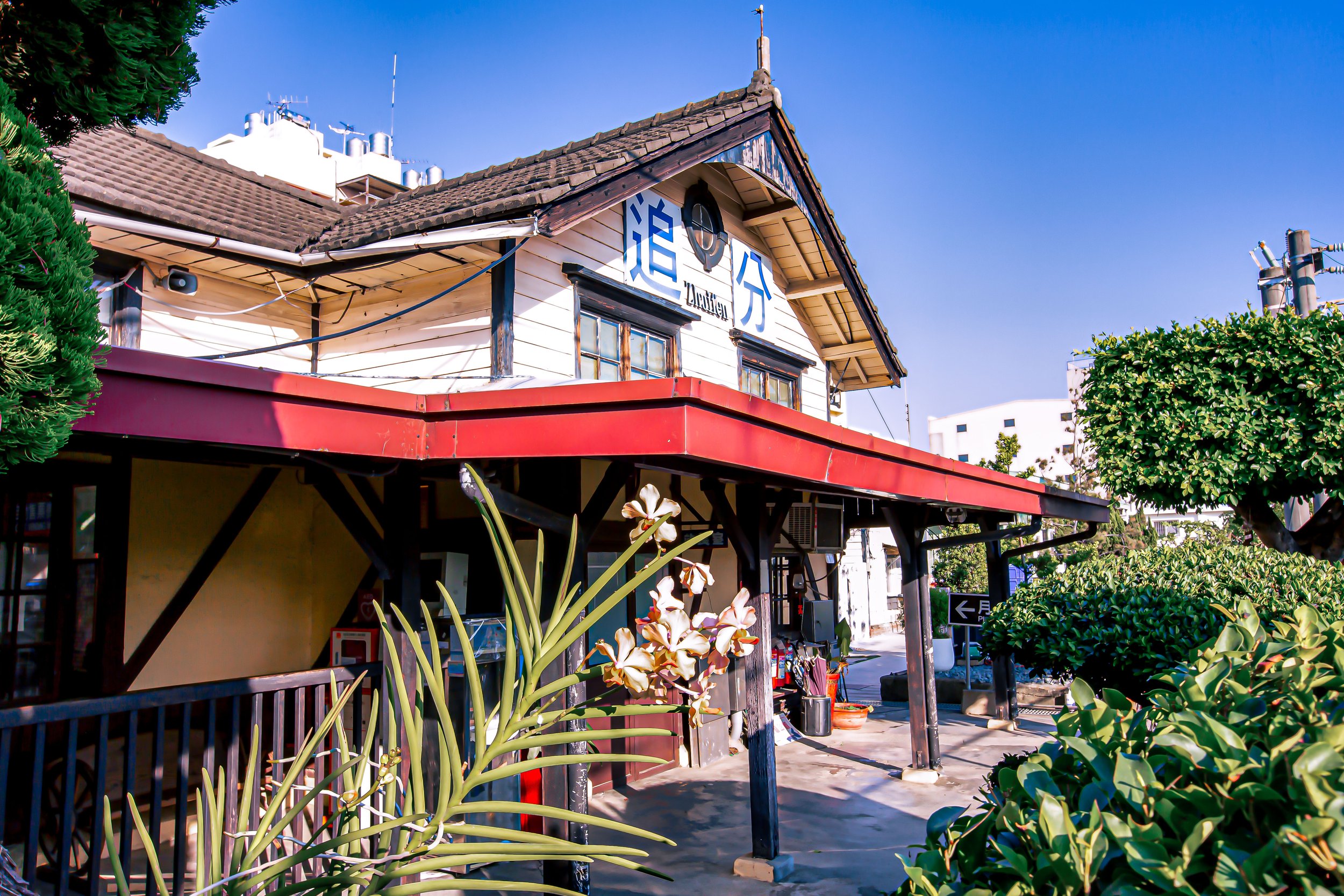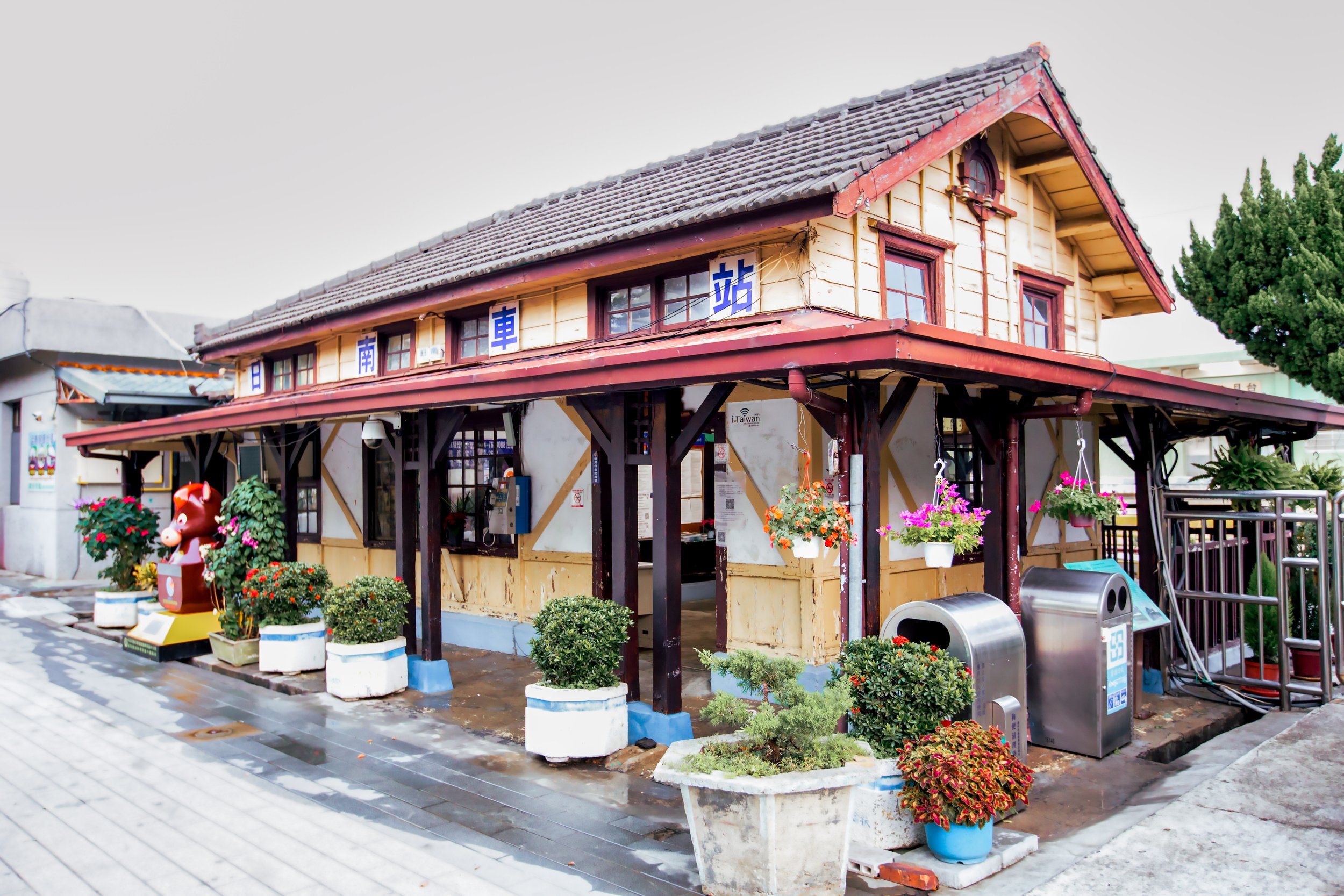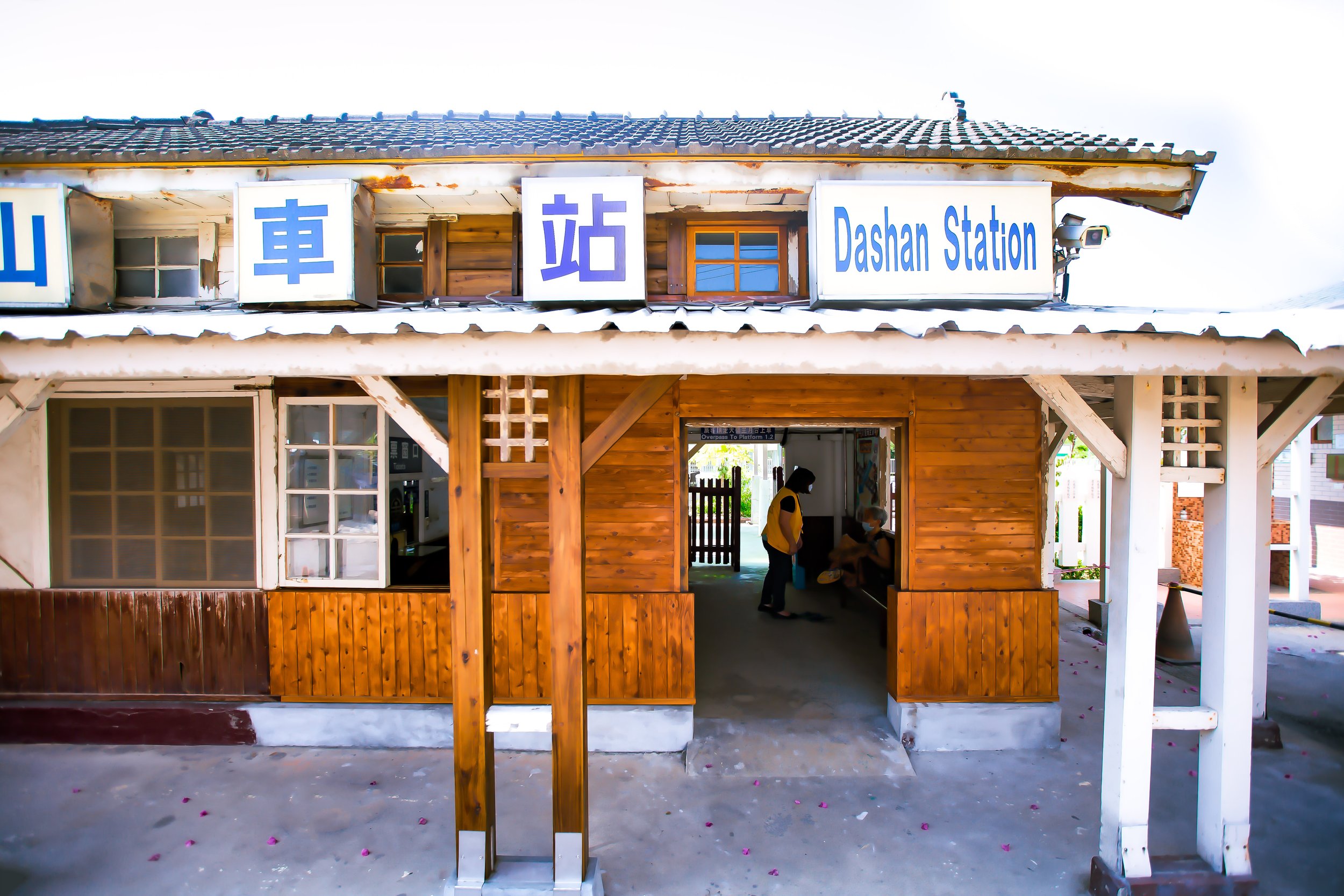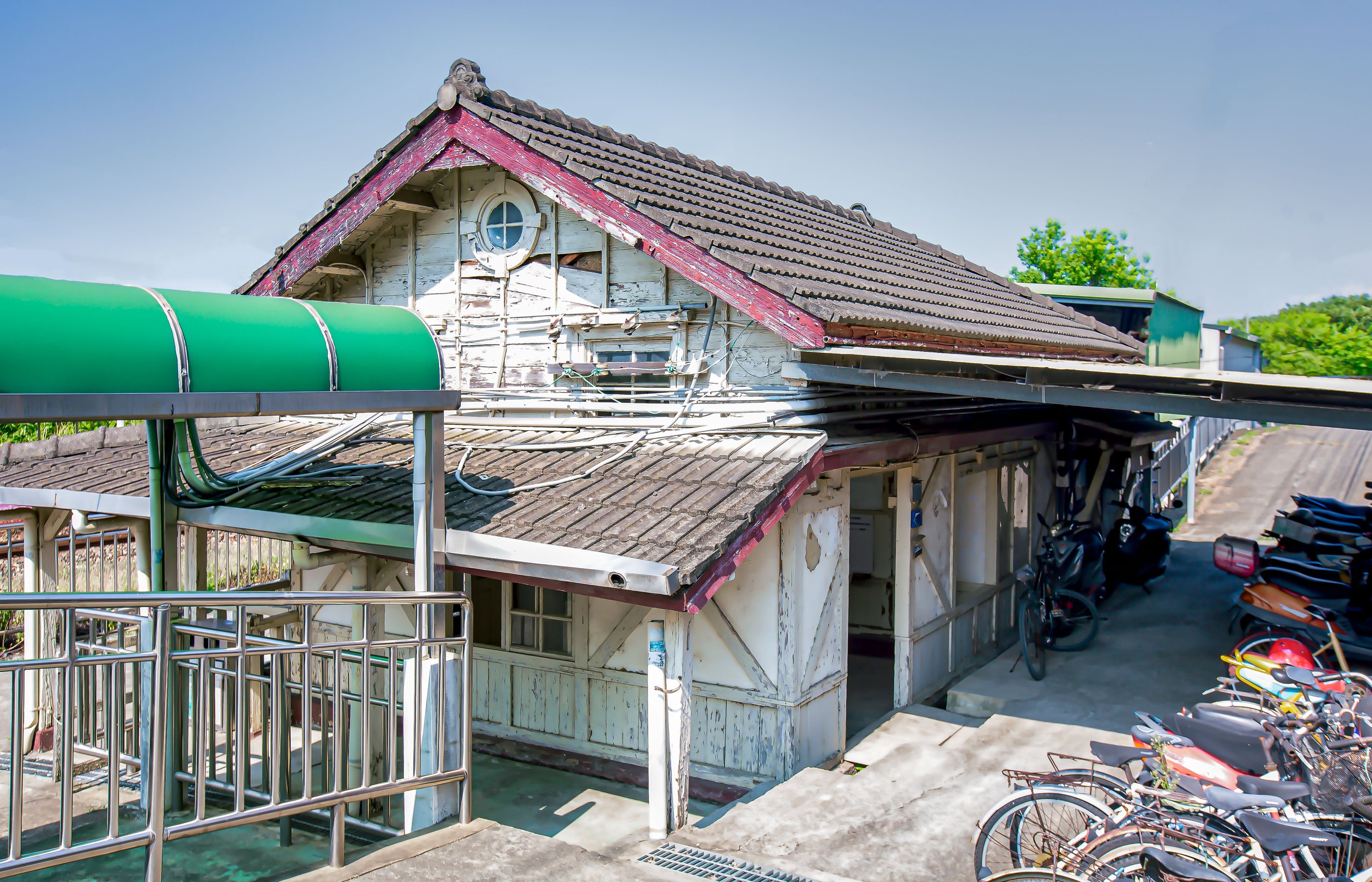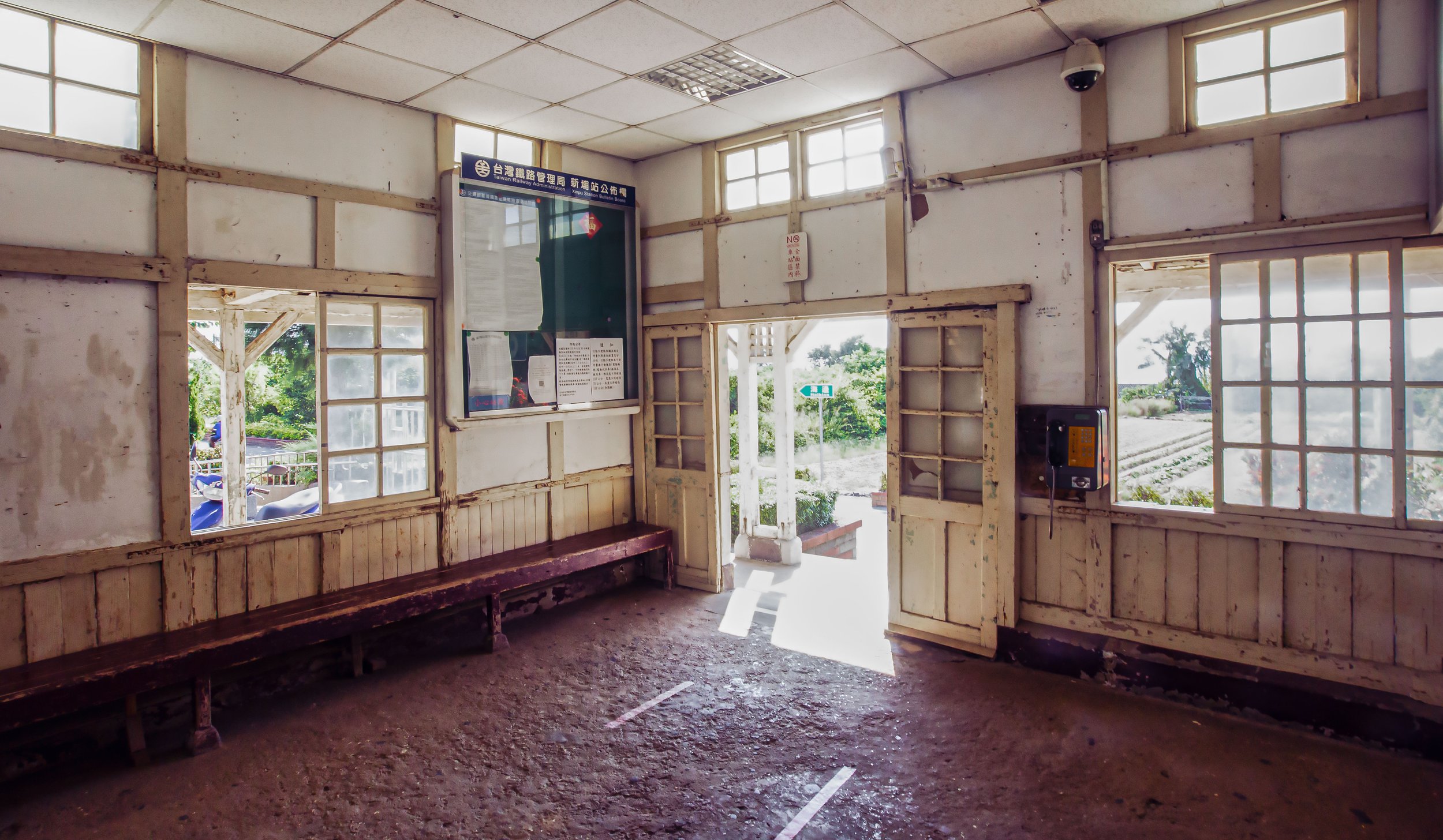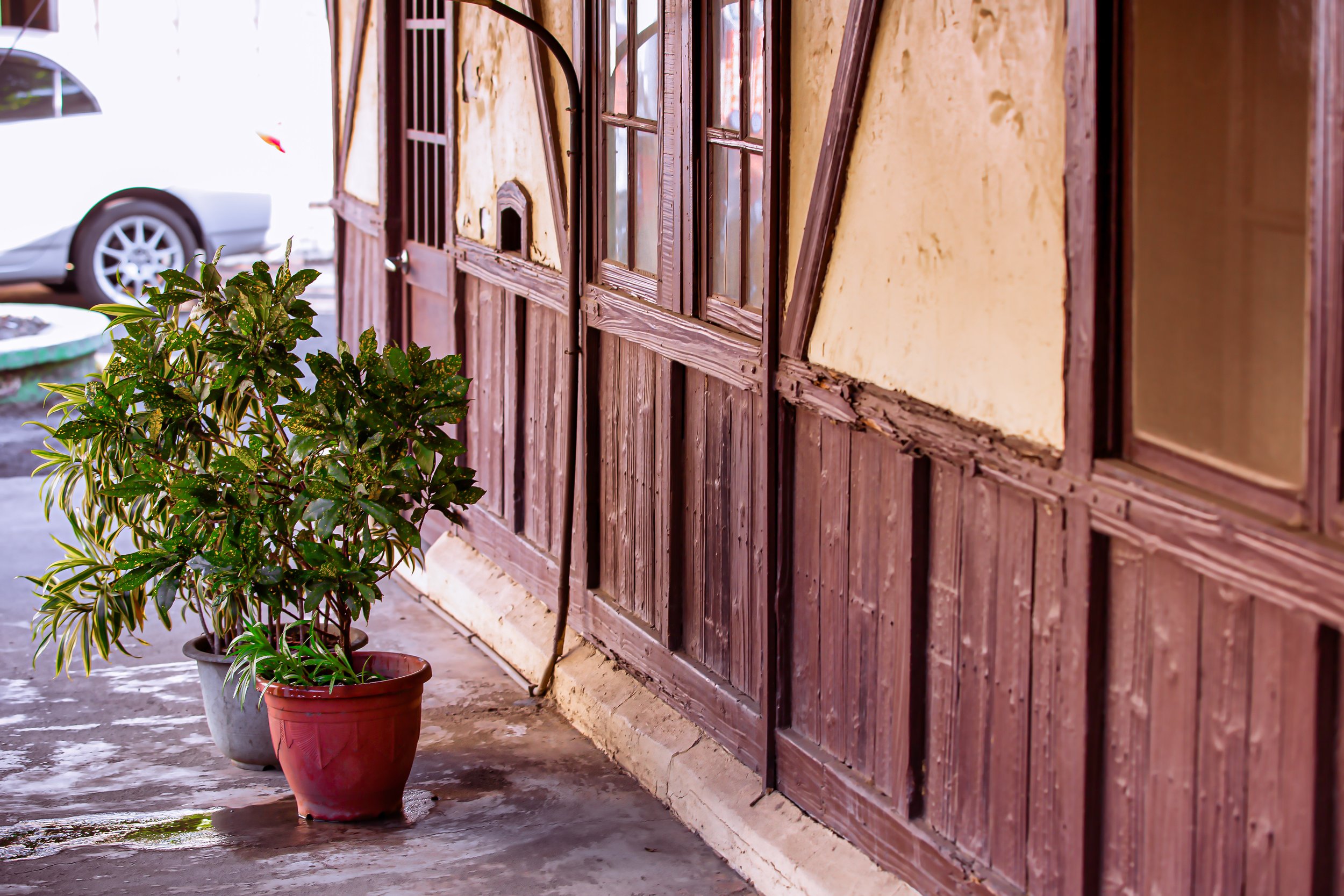Years ago, when I first started combining photography with writing about Taiwan, I didn’t really have any idea where this whole blogging thing would take me. I figured I’d simply share photos of places I was traveling to in my free time with a bit of information about them. Then one day, on a scooter trip to Hsinchu, I decided to stop by the yet to be restored Longtan Martial Arts Hall thanks to a tip from a friend. That visit spawned a several-year long research project into Taiwan’s Japanese Colonial era, resulting in visiting almost all of the remaining Martial Arts Halls as well as many other train stations, civic buildings, dormitories, etc.
What started out as a simple visit to a semi-abandoned building transformed this space into one of the most authoritative spaces on the web that tells the story of these former Martial Arts Halls; Having visited a large percentage of the halls that remain in Taiwan today, I decided to write a general guide so that people could learn more about their complicated history.
More specifically, the guide features a list of sixteen remaining halls, most of which have been restored and re-opened to the public as historic tourist destinations. There were a few on the list however that were somewhat questionable as to whether or not they’d ever be restored. The Xinzhuang Martial Arts Hall (新莊武德殿) and the former Hsinchu Juvenile Prison Martial Arts Hall (新竹少年刑務所演武場), for example were two that had an uncertain future.
I’m happy to report however that the Xinzhuang Martial Arts Hall is currently being restored, and it should be re-opened within the next year or two. Even better is that the Hsinchu Prison Hall has already been restored and is open to the public. If you know me, I follow these developments pretty closely, and I had seen news and some photos regarding the start of the restoration process of the latter, but I never really expected that it’d be completed so quickly!
I’m happy to report that I’m here with yet another article introducing one of the nation’s newest fully restored Martial Arts Hall - Before I start though, I have to give some mad props to the Hsinchu City Government, which did an amazing job restoring this historic building. Likewise, I have to give them credit for what I consider to be the most informative and comprehensive descriptions of the history and the architecture of the building that I’ve seen. In most cases, I’d find myself stuck in the library of the national archives doing extensive research on the architectural specifics of these buildings, but almost all of the information that anyone needs to learn about the hall is provided within, which is great!
I don’t consider myself easily impressed given that over the years I’ve observed despite a willingness on the part of the government to spend a bunch of money restoring these buildings, rarely is the due diligence ever done when it comes to telling their story properly. The Hsinchu City Government though has gone above and beyond - and that is something that has observably become the norm as of late as the Hsinchu Aqueduct (新竹街水道取水口), features similarly thorough informative displays.
With the massive Hsinchu Public Hall (新竹公會堂) set to reopen in the near future, I find myself quite optimistic for what the city will do with the space, especially since Japanese-era buildings of its size and importance are about as rare as the Martial Arts Halls.
It seems like there are few places in Taiwan that are doing as well as Hsinchu with regard to its preservation of historic buildings, so I’m sure I’ll be visiting the city quite often in the coming months and years!
Hsinchu Prison Martial Arts Hall (新竹少年刑務所演武場)
In 1900 (明治33年), construction on Martial Arts Halls in Taiwan started with the first in Taipei (臺北州/たいほくしゅう), Taichung (臺中廳/たいちゅうちょう) and Tainan (臺南廳/たいなんちょう) initially meant to assist in the training of the local police in martial arts. It wasn’t until after the “Taiwan Butokuden Branch of the Dai Nippon Butoku Kai” (大日本武德會臺灣支部) was established in 1906 however that we started to see these Martial Arts Halls popping up all over the island.
By 1920 (大正9年), the organization was given a directive from the central government to start construction on Martial Arts Halls in each of Taiwan’s prefectures culminating in the eventual construction of more than two-hundred across the Island over the next two decades.
In Taiwan, the halls initially served the purpose of training the police, military and prison guards in Japanese martial arts disciplines. Later, they opened up to the general public in an attempt to train the citizens of Taiwan in Japanese martial arts, as well as instilling "Japanese Spirit," better known as Yamato-damashii (大和魂).
While they weren’t considered civic buildings, the Martial Arts Halls were often constructed in strategic locations within cities and towns close to the governing district. This helped the government to better pass down directives to the organization in addition to ensuring that funding was available to help promote Martial Arts disciplines and Japanese cultural values.
As I introduced in my guide to Taiwan’s Martial Art Halls, more than two-hundred of these buildings were constructed across the island, varying in size based on their status within the hierarchy of the organization. Of that total, eleven were classified as “Prison Branches” (刑務所), where staff of the prisons around the island were trained in Martial Arts and self-defense techniques.
Keeping in mind that the Prison Branches were the rarest of the bunch, its pretty cool that a handful of them continue to exist today, namely the Taichung Martial Arts Hall (臺中刑務所演武場), the yet to be restored Tainan Prison Martial Arts Hall (臺南刑務所演武場) and the former Shinchiku Prefecture Juvenile Prison Martial Arts Hall (新竹少年刑務所演武場).
To introduce the history of this nearly one hundred year old building, we first have to talk about the reason for which it was constructed, given that it was just a small piece of the Shinchiku Juvenile Prison (新竹少年刑務所 / しんちくしょうねんけいむしょ), the first of its kind in Taiwan.
Officially established on October 7th, 1926 (昭和元年), the detention centre had a maximum capacity of just over five-hundred inmates, and came fully equipped with recreational facilities, a Shinto Shrine, a church, staff housing (just outside of the walls), and of course the Martial Arts Hall. That being said, official records from the Japanese-era state that even though the facility was where all of Taiwan’s juvenile criminals were imprisoned, there were never more than 350 inmates at any given time.
The history of the prison facility however dates back several decades prior as it was originally the Hsinchu Branch of the Taipei Prison (台北監獄署新竹支署), which opened in 1896 (明知29年). Over next few decades the facility was renamed several times, while also expanding with the construction of new buildings while the colonial government was busy refining Taiwan’s territorial boundaries and civil system. By 1923, the prison was one of the four largest on the island, but was still re-designated three years later into Taiwan’s first Juvenile Penitentiary.
Although it has been repaired, expanded and rebuilt on several occasions, the prison has stayed in continuous operation for 130 years, becoming the Hsinchu Prison (新竹監獄) after the end of the Second World War until now.
As part of the continued expansion of the prison and the facilities that surrounded it, a Martial Arts Hall was constructed within the community of employee housing along the eastern wall. Completed in 1935 (昭和10年), the hall served as a space to assist the employees of the prison in the art of self defense.
As we’ve seen with some of the other Martial Arts Halls around the country, the official name of the hall was a long and convoluted one, officially known as the ‘Hsinchu Juvenile Prison Martial Arts Dojo’ (新竹少年刑務所演武場 / しんちくしょうねんけいむしょえんぶじょう).
While still falling under the operational control of the (equally convoluted) “Taiwan Budoken Branch of the Dai Nippon Butoku Kai” (大日本武德會臺灣支部), this particular hall was regarded as an “enbujo” (演武場 / えんぶじょう), or a “Martial Arts Performance Centre” rather than a full-fledged “Budokuden” (武德殿 / ぶとくでん) given that the Hsinchu Martial Arts Hall (新竹武德殿) was located a short distance away.
For those who can’t differentiate between the Chinese characters, it can be a bit confusing given that the majority of Taiwan’s remaining Martial Arts Halls are referred to in Japanese as “Butokuden”.
Link: The Hsinchu Prison Butokuden and Dormitories (新竹演武場) Over The City
It was common however during the Japanese-era to refer to also use either “Budojo” (武道場), “Renbukan” (練武館) or “Enbujo” (演武場) to refer to the halls. Essentially, the naming of the halls, or at least their official designation was part of a formula used to differentiate their structural hierarchy within the organization.
While the ‘enbujo’ variety tended to be smaller, the key thing to remember is that in their official names you’d still find the words “Butoku Kai” (武德會) preceding the rest of the name - In this case, this hall would have been officially referred to as a “Butoku Kai Enbujo” (武德會演武場 / ぶとくかいえんぶじょう).
I realize this all might seem a bit confusing, but the Japanese are known for strict adherence to organizational hierarchy, which if you’re able to figure out actually makes sense.
Despite its size, the Martial Arts Hall offered the same classes that you’d find at any of the others around Taiwan with one side of the building reserved for Judo (柔道), and the other for Kendo (劍道). The exterior of the building likewise would have had a space for practicing Kyudo (弓道), otherwise known as Japanese archery.
Suffice to say, the Martial Arts Hall was constructed only a decade prior to the end of the colonial era, so in 1945, when the Japanese relinquished control of Taiwan under the terms of their surrender, the hall ceased being used for its original purpose. After the war, the Chinese Nationalists used it for housing for prison staff as there was a housing crisis caused by the millions of refugees who fled to Taiwan with the incoming regime.
To meet the needs of the residents of the building, alterations were made to its original design over the years making it a shadow of its former self some hideous modern additions that covered up almost all of its architectural design. Suffice to say, the building and most of the dorms that surround the prison were eventually abandoned as they aged, and the residents found more comfortable accommodations elsewhere.
The Martial Arts Hall was officially registered as a Hsinchu City Protected Heritage Building (市定古蹟) on July 26th, 2012, which by law meant that plans would have to be drawn up to have the building restored.
It ended up taking a few years, but restoration on the building started in the summer of 2018.
Then, after a several year-long restoration project, the Martial Arts Hall officially reopened to the public on November 11th, 2021, a little over three years after the project started.
Before I move on to introducing the architectural design of the Martial Arts Hall, I’ll provide a brief timeline of events in order to give you a better idea of its history:
Martial Arts Hall Timeline
1895 (明治28年) - Japan takes control of Taiwan and starts its occupation of the island.
1896 (明治29年) - The Hsinchu Branch of the Taipei Prison (台北縣新竹監獄署) is established.
1900 (明治33年) - Taiwan’s first Martial Arts Halls are constructed in Taipei, Taichung and Tainan.
1923 (明治30年) - The Prison is renamed “Hsinchu Prison” (新竹刑務所)
1926 (昭和元年) - The Hsinchu Juvenile Prison (新竹少年刑務所) is officially established.
1935 (昭和10年) - The Juvenile Prison Martial Arts Hall (新竹少年刑務所演武場) is established.
1945 (民國34年) - Japan surrenders to the allies and control of of Taiwan is given to the ROC.
1945 (民國34年) - The Juvenile Prison is officially renamed Hsinchu Prison (新竹監獄)
1945 - 2012 - The Martial Arts Hall is used as a dormitory for Prison employees (監獄員工宿舍).
2012 (民國101年) - The Martial Arts Hall is registered as a protected historic building (市定古蹟).
2018 (民國107年) - Restoration on the Martial Halls Hall begins.
2020 (民國109年) - Restoration on the hall is officially completed.
2021 (民國110年) - The Martial Arts Hall officially reopens as a tourist attraction.
Architectural Design
As I mentioned above, this Martial Arts Hall can be considered one of the most ‘complete’ of the few that remain in Taiwan today, given that both the main section of the hall and the annex remain intact. However, I’d be remiss if I didn’t mention that in recent years, there has been more emphasis put into ensuring that the larger halls around the country are restored in a way they are as ‘complete’ as this one.
To explain what I mean, when these Martial Arts Halls were originally constructed during the Japanese era, they almost always included an annex building, used as an administrative and living space. Additionally, you were also likely to find space on the exterior of the building reserved for traditional Japanese archery.
When the halls started being restored, almost all of the attention was placed solely on the main hall, leaving the rest of the facility more or less incomplete.
Thankfully, due to the popularity of the Martial Arts Halls as tourist attractions, and the potential for the annex to be used as an exhibition space, or a spot that could be rented out, they’ve started to make their reappearance next to some of the already restored halls. Most recently, the Daxi Martial Arts Hall (大溪武德殿), the Qishan Martial Arts Hall (旗山武德殿), the Changhua Martial Arts Hall (彰化武德殿) and the Taichung Prison Martial Arts Hall (臺中刑務所演武場) are a few examples where the annex was added after the restoration of the main hall.
Link: The role of Public-Private Partnerships in Conserving Historic Buildings in Taiwan
One of the main differences between the halls mentioned above and this particular hall is that the annex building was connected directly to the rest of the building, and was restored simultaneously making it a complete experience. Yet another reason for my high level of praise for the building.
Officially, the Martial Arts is split into three ‘sections’, but architecturally-speaking it’s much easier to just say its split into two given the difference in the materials used to construct each side.
The Martial Arts side was constructed with a mixture of brick, wood and reinforced concrete, one of the defining characteristics of the period when it was built. The annex side on the other hand was constructed with traditional Japanese architecture in mind in that it was constructed primarily of wood.
Keeping in mind that this is inherently a ‘east-west fusion’ style building, there are some obvious design differences between the two sections, but it’s important to first note where they are the same: To start, both sections are elevated off of the ground on a concrete base. One of the things that Japanese architects learned quickly upon arrival in Taiwan was that the island’s termites are a feisty bunch so in order to preserve the structural integrity and the longevity of buildings, it was common for all of them to be elevated off the ground. However, given that this is a Martial Arts Hall, the elevation is a bit higher than ordinary buildings as the it features a network of springs beneath the floor allowing for some spring in your step.
This is yet another area where the restoration of the hall shines as it is (currently) one of two where you’ll still find springs beneath the floor, adding to the ‘completeness’ mentioned above.
The next similarity is that both sides of the building were designed using the traditional Japanese Irimoya-zukuri (入母屋造 / いりもやづくり) architectural design. What this means is that the building makes use of a variation of the ‘hip-and-gable’ roof, and that the base of the building, known as the ‘moya’ (母屋) was constructed in a way that it is much smaller than the roof, but is able to support its weight. In this case, the roof, which isn’t nearly as grand in design as the Taichung Prison Martial Arts Hall only slightly eclipses the base. That being said, the subdued design of the roof doesn’t necessarily mean there isn’t a lot going on as it seamlessly ‘cuts’ from the higher section of the Martial Arts Hall to the lower annex section.
This where you’ll find the next important architectural similarity - The roof of the Martial Arts Hall and the annex was designed using the ubiquitous kirizuma-zukuri (妻造的樣式) style, which is one of the oldest and most commonly used designs in Japan. Translated simply as a “cut-out gable” roof, this style of design is one of the simplest of Japan’s various ‘hip-and-gable’ roofs.
The vast majority of the information you’ll find available about the Martial Hall’s architectural design mentions that the roof was constructed using traditional Japanese black tiles (日式黑瓦), but doesn’t really go much further in explaining the finer details of the roof. Fortunately, I’ve been at this for a while, so I’m able to provide a little more in terms of the design aspects of the roof where you’ll find the following as listed on the diagram below.
Hiragawara (平瓦 /ひらがわら) - A type of arc-shaped clay roofing tile.
Munegawara (棟瓦 /むねがわら) - Ridge tiles used to cover the apex of the roof.
Onigawara (鬼瓦/おにがわら) - Decorative roof tiles found at the ends of a main ridge.
Nokigawara (軒瓦/のきがわら) - The roof tiles placed along the eaves lines.
Noshigawara (熨斗瓦/のしがわら) - Thick rectangular tiles located under ridge tiles.
Sodegawara (袖瓦/そでがわら) - Cylindrical sleeve tiles
Tsuma (妻/つま) - The triangular shaped parts of the gable on the roof under the ridge.
Hafu (破風板/ はふいた) - Bargeboards that lay flat against the ridge ends to finish the gable.
To describe it simply, a kirizuma-style roof has a section that ‘cuts’ out from the rest and faces outward like an open book (入), while the longer part is curved facing in the opposite direction.
In this specific case, if we think of the building as a single structure rather than one that is split in two, it is shaped somewhat like the letter “U”. The highest (and longest) section of the roof curves like an open book with the two ends acting as the ‘cut out’ sections. It then meets with the two branches that face in the opposite direction, which are also curved like an open book.
Even though I mentioned above that the roof of this Martial Arts Hall isn’t as grand in comparison, it is still quite complicated in its architectural design and it’s 3D-like appearance. I recommend anyone who visits to walk around the entire perimeter of the building so that you can fully appreciate the complexity of its design.
One thing you’ll want to keep in mind is that the black tiles mentioned had to be completely replaced with newer tiles, so the roof doesn’t as appear as ‘historic’ as it probably should.
You can find some very thorough displays featuring the original tiles within the annex building, which I highly recommend you take some time to enjoy.
Now, let’s talk about how the two parts of the building are different.
Starting with the Martial Arts Hall side, it was constructed with a concrete base, bricks and reinforced concrete on the exterior and wood within the interior. The front facade of the building makes use of a fusion style of architectural design in that it features Western-style Art-Deco elements with the inclusion of a traditional Japanese-style kurumayose (車寄/くるまよせ) porch directly in the middle of the building.
The porch had to be completely rebuilt during the recent restoration process, and features a similarly designed kirizuma-style roof facing in the opposite direction of the roof above, adding to the three dimensional design of the building. This would have proven to be one of the most difficult aspects of the restoration project as the team would have had to consult nearly century-old blueprints to faithfully reconstruct the portico.
One of the design similarities that you’ll find on this building and others built during the Showa era are the wooden-panel glass windows that mix with the reinforced concrete on three sides of the building. With two of the large windows on each side of the porch on the front of the building as well as three on the eastern and western sides, the windows allow for a considerable amount of natural light in the building when the sun is up.
Moving on to the interior of the building, the hall is split into two sections (hence the three buildings mentioned above) where half of the building was reserved as a space for Judo (柔道場) while the other half was reserved for Kendo (劍道場). Both sides of the building feature the same hardwood spring floor (彈簧地板) that allows the floor to better absorb the shock of people constantly being thrown around.
The interior space has a height of 270 centimeters in the main building with the total interior space listed as 206.2㎡. What that number unfortunately doesn’t tell us is the exact measurement of space reserved for each section of the building. Even though the Martial Arts Hall is relatively small in comparison to the others around Taiwan, the interior space of the main building remains quite spacious as it was always more or less a completely open space.
Working together with the windows on the three reinforced-concrete sides of the Martial Arts Hall, you’ll find another large windowed section on the side of the building directly opposite to the door. The wooden annex section of the building has two wings that face outward from the rest of hall separated by this space.
The smaller wing on the right is where the restrooms were located, while the larger side on the left was the administrative and living space for those who worked at the hall. As you pass through the Martial Arts Area you’ll find another door to your left that would have served as the main entrance for those working or living there. Directly next to that porch area you’ll find two rooms with tatami mats on the floor.
The first of the rooms you’ll find in the annex section would have served as a living space, while the room next to that features a “tokonoma” (床の間/とこのま), indicating that it was a sleeping space. These days you’ll find some pretty awesome informative displays about the history and architectural design of the building in these rooms.
As far as I’m concerned, the star of this section is the beautiful ‘engawa’ (緣側/えんがわ) that reaches around the building in what seems like an almost 90 degree angle. Essentially a glass-covered panel with sliding doors, the space is one that absolutely glows in the afternoon sun, and would have made living in the hall an enjoyable experience, especially with the breeze flowing through the veranda when the sliding doors were open.
On a recent visit to the Qidong Dorms in Taipei, I found myself engaged in a long conversation with a volunteer working there, who is somewhat of an expert in Taiwan’s Japanese-era architecture. One of the things that he mentioned that stuck with me was how these 90 degree glass paneled verandas were something that (at the time) you’d only find here in Taiwan given that there were some variations on traditional Japanese architectural design in the colony. While I’m unsure that it is still the case back in Japan, these ‘L’ shaped glass-covered walls were pretty cool and the natural light that they allowed into the building.
Although, I can’t really imagine the terror you would have felt when a typhoon was rolling through town.
Getting There
Address: #18-20 Guangzhou Street, Alley #20, Hsinchu City (新竹市北區廣州街20巷20號)
GPS: 24.804621, 120.960528
Hours: Tuesday - Sunday from 9:00am to 17:00pm.
Car / Scooter
As always, if you’re driving a car or scooter, I recommend copying the address provided above into your GPS or your Google Maps to map out the route most suitable for you. If you’re in Hsinchu, it shouldn’t take you much time to arrive at the hall given that it is located just outside the historic downtown core of the city.
If you’re driving a car, you should be able to find roadside parking nearby on Beida Road (北大路), but you may have to circle around to find a space. Unfortunately, paid parking lots are somewhat of a distance away, so if you find yourself searching for a spot you might just want to go to one of the paid spaces near the jail.
If you’re driving a scooter on the other hand, you can park directly across the street, or in any of the designated scooter parking spaces nearby. You could even park in the alley directly across from the main entrance to the hall if you’re visiting on a day when there aren’t many tourists.
Bus
With a bus stop located directly across the street from the Martial Arts Hall, getting there by bus is one of your best options if you find yourself in town without access to your own means of transportation.
From the Hsinchu Railway Station, you can conveniently take either Bus #10, or Bus #23 to the hall, getting off at the aptly named Service Centre Bus Stop (服務中心站).
Click on the links provided above to access time tables for each of the bus routes.
YouBike
Another excellent way to get around Hsinchu is to enjoy the city on one of the YouBikes that are available for rent. If you arrive in town on the train, you can easily grab a Youbike near the station and explore all that the historic city has to offer at your own leisure.
You may have heard that Hsinchu is somewhat notorious for its chaotic traffic, but riding a Youbike around town is actually quite comfortable thanks to the wide roads.
From the train station, it’s a 1.4km ride to the Martial Arts Hall riding along Linsen Road (林森路) and Shengli Road (勝利路), both of which are large bike friendly roads. There are a number of locations where you’ll probably want to stop along the way, so I recommend using Google Maps on your phone to map out your route so you don’t get lost.
Trust me, Hsinchu is a city where you can easily find yourself losing your way while exploring the historic streets. That’s not entirely a bad thing though.
If you’ve been following all of the work I’ve done on the Martial Arts Halls of Taiwan over the past few years, it should be fairly obvious from this article that I’m quite pleased with the addition of this particular hall the collection. Not only was its restoration and subsequent re-opening somewhat unexpected, I have to give the Hsinchu City Government some massive props for the amazing restoration job as well as the effort put into providing informative and educational materials about the history of the hall, the juvenile prison and the city during the Japanese-era.
What amazed me most were the detailed and graphic heavy descriptions of the architectural design of the hall, something that I often have to spend quite a bit of time researching.
Very few of the other remaining Martial Arts Halls around the country today offer even a fraction of the detailed historic information as this one, so if I’m this impressed, I’m sure others may also appreciate the hard work put into making this Martial Arts Hall a great spot to visit!
References
新竹少年刑務所演武場 (Wiki)
新竹少年刑務所 (Wiki)
臺灣的武德殿 (Wiki)
新竹州 | Shinchiku Prefecture (Wiki)
台灣武德殿發展之研究 (黃馨慧)
市定古蹟「新竹少年刑務所演武場」 修繕動工 (自由時報)
新竹監獄化身藝文空間!「新竹少年刑務所演武場」開館,一窺日治時期古蹟木構磚造建築特色 (Shopping Design)
新竹少年刑務所演武場 (國家文化資產網)
新竹少年刑務所演武場 (Path of Sunrise)
新竹日治時代監獄變身藝文空間!走進演武場的前世今生 (LaVie)
新竹武德殿 (The Memory of Hsinchu City)

































